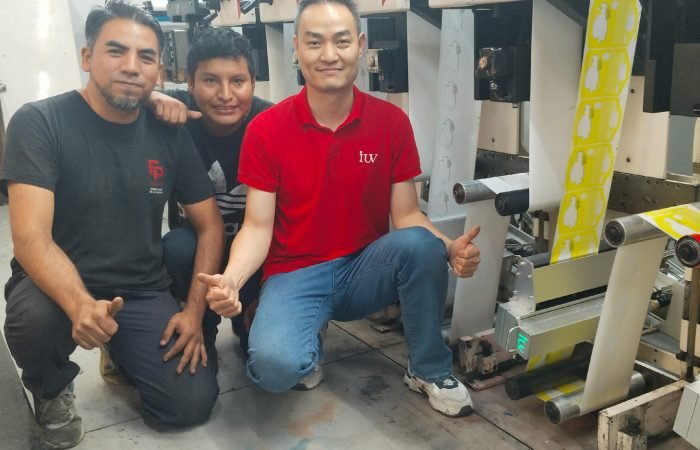Achieving superior adhesion and ink transfer on difficult substrates is a persistent challenge in modern printing. This is especially true for narrow web label printing, flexographic, and offset printing applications. Traditional UV curing systems often fall short when dealing with non-porous or specially coated materials. However, the advent of LED UV curing technology has revolutionized these processes, offering significant improvements in both adhesion and ink transfer.
Understanding the Challenge of Difficult Substrates
Difficult substrates, such as certain plastics, metallized papers, and films, present unique hurdles for printing inks. These materials often have low surface energy, meaning ink struggles to wet the surface and form a strong bond. This can lead to poor adhesion, ink rub-off, and delamination issues. Furthermore, achieving consistent and high-quality ink transfer can be problematic. In flexographic printing, for example, precise ink laydown is critical for fine details and solid coverage. In offset printing, achieving sharp dots without spreading is paramount.
The Limitations of Traditional UV Curing
Traditional mercury-based UV lamps emit a broad spectrum of UV light. While effective for many applications, they come with several drawbacks. They generate significant heat, which can warp or distort heat-sensitive substrates. Their energy output is also less consistent, often requiring frequent bulb replacements and causing variations in cure levels. This inconsistency can directly impact adhesion and ink transfer, as an incomplete cure results in a weaker bond between the ink and the substrate. The heat generated can also affect the viscosity of some inks, influencing their transfer characteristics.
How LED UV Curing Enhances Adhesion
LED UV curing systems offer a fundamentally different approach. They emit UV light at specific wavelengths, precisely tailored to the photoinitiators present in UV-curable inks. This targeted energy delivery is far more efficient.
- Precise Wavelengths: LED systems emit concentrated wavelengths, often in the UVA range. These wavelengths are highly effective at initiating the polymerization of UV inks. This complete and rapid polymerization is the key to achieving robust adhesion. The ink cures into a solid, cross-linked polymer matrix that physically bonds with the substrate.
- Lower Heat Emission: Unlike mercury lamps, LEDs generate very little heat. This is a game-changer for printing on heat-sensitive plastics and films. Reduced heat prevents substrate deformation, ensuring dimensional stability and allowing for more consistent ink transfer. When the substrate remains stable, the ink can cure uniformly across the printed area, leading to stronger adhesion.
- Consistent Energy Output: LED lamps offer a stable and consistent energy output throughout their lifespan. This means every print job receives the same level of curing energy, leading to predictable and repeatable results. This consistency directly translates to reliable adhesion, batch after batch.
Improving Ink Transfer with LED Curing
Beyond adhesion, LED UV curing also significantly improves ink transfer, a critical factor in both flexographic and offset printing.
- Rapid Curing: The instant on/off capability of LEDs allows for immediate curing of the ink as it is transferred from the printing plate or form to the substrate. In flexographic printing, this rapid setting of the ink on the substrate prevents unwanted ink spread or “dot gain.” This means finer details, sharper edges, and cleaner solids are achievable. The ink is essentially locked in place as soon as it hits the surface.
- Controlled Ink Viscosity: The low heat output of LED curing prevents the ink from overheating and thinning excessively during the printing process. This controlled viscosity ensures that the ink transfers cleanly and accurately from the anilox roll (in flexo) or the printing plate (in offset) to the substrate. Consistent ink viscosity leads to predictable ink film thickness and excellent print quality.
- Enhanced Ink Properties: Many modern UV inks are formulated specifically for LED curing. These inks contain photoinitiators that are highly responsive to the specific wavelengths emitted by LEDs. This formulation synergy allows for faster cure speeds and often results in inks with improved mechanical properties, such as scratch and chemical resistance, which further contribute to a durable and well-transferred print.
Applications in Narrow Web, Flexo, and Offset Printing
For narrow web label printers, the ability to print on a wide range of challenging substrates like PET, BOPP, and shrink sleeves is crucial. LED UV curing enables them to achieve excellent adhesion and scuff resistance on these materials, opening up new market opportunities.
In flexographic printing, especially for high-volume labels and packaging, consistent ink transfer is paramount. LED curing ensures that fine text and detailed graphics are reproduced with clarity and sharpness. The enhanced adhesion means prints are more durable and less prone to damage during handling and distribution.
For offset printers, particularly those working with sheetfed or web offset, LED UV curing on plastics or coated papers can be a significant advantage. It allows for immediate handling of printed sheets without smudging, improving workflow efficiency. The improved adhesion also makes offset printing a viable option for applications previously limited to other technologies.
Choosing the Right LED System
When selecting an LED UV curing system, several factors are important. The specific wavelength output (e.g., 365nm, 395nm) should match the ink formulation. The power density (irradiance) determines the speed of the cure, and the total energy dose (energy per unit area) is also critical for achieving a complete cure. Working with ink and equipment manufacturers can help identify the optimal LED solution for specific substrates and printing processes.
In conclusion, LED UV curing technology offers a powerful solution for overcoming the challenges of printing on difficult substrates. Its ability to deliver precise wavelengths, generate minimal heat, and provide consistent energy output dramatically improves both ink adhesion and transfer. This leads to higher print quality, increased durability, and expanded application possibilities for narrow web, flexographic, and offset printers.












